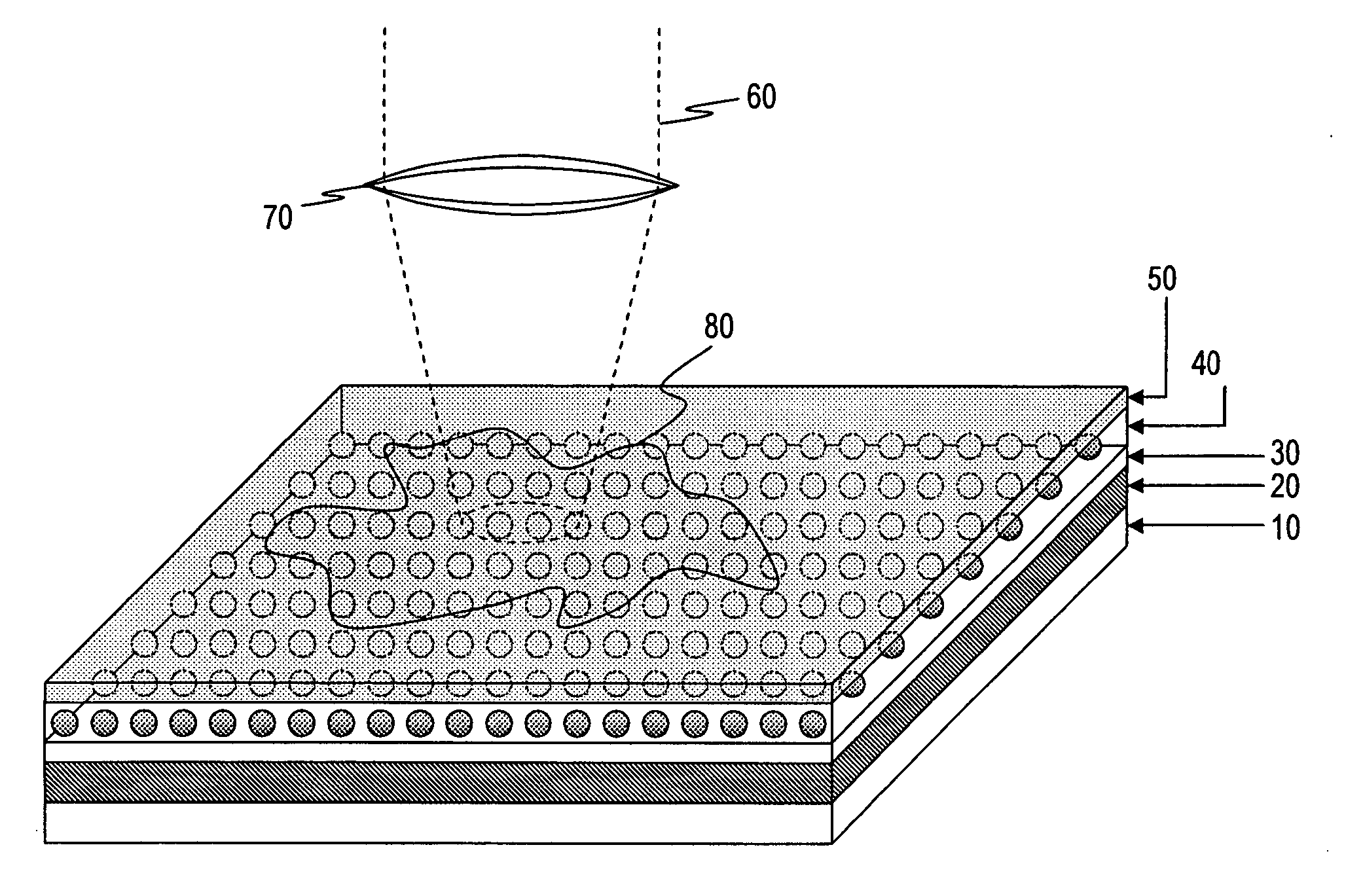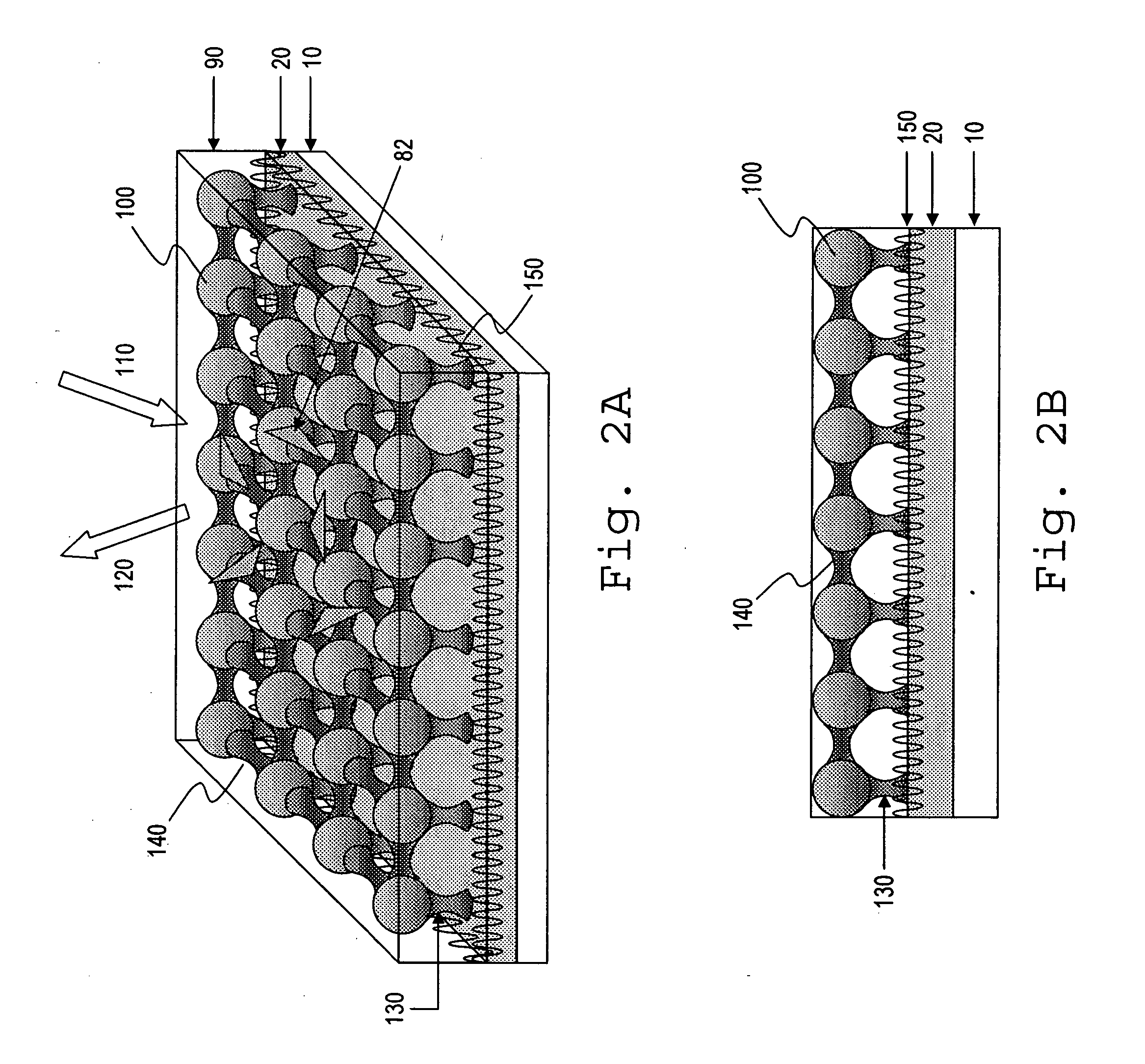Optical sensor with layered plasmon structure for enhanced detection of chemical groups by SERS
a technology of enhanced detection and optical sensors, applied in optical radiation measurement, instruments, spectrometry/spectrophotometry/monochromators, etc., can solve the problems of limiting the sensitivity of such a system, difficult to structurely characterize particles, and inability to reproduce the enhancement degr
- Summary
- Abstract
- Description
- Claims
- Application Information
AI Technical Summary
Benefits of technology
Problems solved by technology
Method used
Image
Examples
example 1
Preparation of a Silver-Silver Particle Nanostructure by Self-Assembly of Ag Nanoparticles
[0117] For each of a number of slides, a silver mirror was deposited on a clean glass microscope slide by thermal evaporation of the silver (99.995%) using vacuum deposition system (E302, Edwards). The slides were immersed in a 1% aqueous polylysine solution for one hour, forming a polylysine dielectric layer over the silver film. Following rinsing in copious amount of water, the slides were exposed overnight to a silver nanoparticle suspension of optical density 5 at extinction maximum of 450 nm. The self-assembly of the silver particles on the surface resulted in the yellow hue (appearance) of the mirrors. The slides were then rinsed with water and exposed to different analytes for various time periods. After the adsorption of analyte molecules slides were interrogated with Raman spectrometer yielding SERS spectra.
[0118] In the second example, silver nanoparticles were adsorbed on the surfa...
example 2
Preparation of Samples with Self Assembled Silver Particle Nanostructure by Microcontact Printing
[0119] In this example, a method of microcontact printing as disclosed for example in reference (H. S. Shin, et. al. “Direct patterning of silver colloids by microcontact printing: possibility as SERS substrate array”, Vibrational Spectroscopy, v. 29, p. 79-82, 2002, H. Fan et al., “Self-Assembly of Ordered, Robust, Three-Dimensional Gold Nanocrystal / Silica Arrays”, Science, 304, 567-571 (2004), was used to form a close-packed array of silver nanoparticles on a silver mirror.
[0120] Silver nanoparticles were prepared by method disclosed in Lee P. C., Meisel, D. J., J. Phys. Chem., 86, p. 3391 (1982), Poly(vinyl pyrrolidone) was used as the capping agent. First, silver nitrate (0.2 g, Aldrich, 99+%) was dissolved into 3 mL ethylene glycohol (Aldrich, 99.8%). 1 g polyvinyl pyrrolidone (Aldrich, MW≅40000) was added into 15 mL ethylene glycohol and the mixture was stirred and heated to 197°...
example 3
Experimental Measurements on the Analyte Rhodamine 6 G (R6G)
[0127] The experimental system set up used in present experiments is shown on
[0128]FIG. 7A-7C. Measurements were carried using Horiba-Jobin Yvon Raman microscope LabRam HR 800.
[0129] Measurement of SERS spectra from liquid samples was carried out using a fluidic cell made from borosilicate glass. A schematic diagram of a fluidic cell is presented on FIG. 7A (top view) and in FIG. 7B (cross sectional view). A glass fluidic cell contains fluidic a channel 84 formed on a glass slide 14 to a depth of about 1.2 to 2.0 mm. The thickness' of the SERS-active structure 150 was 0.8 mm. During the experiment, the optimal value of parameters such as depth of fluidic channel was determined, e.g., the best conditions for focusing of the laser light beam through the confocal objective in Raman microscope. Use of the glass cover slip 16 was critical in order to maintain the same thickness of analyte layer during all sets of measurements...
PUM
| Property | Measurement | Unit |
|---|---|---|
| size | aaaaa | aaaaa |
| thickness | aaaaa | aaaaa |
| thickness | aaaaa | aaaaa |
Abstract
Description
Claims
Application Information
 Login to View More
Login to View More - R&D
- Intellectual Property
- Life Sciences
- Materials
- Tech Scout
- Unparalleled Data Quality
- Higher Quality Content
- 60% Fewer Hallucinations
Browse by: Latest US Patents, China's latest patents, Technical Efficacy Thesaurus, Application Domain, Technology Topic, Popular Technical Reports.
© 2025 PatSnap. All rights reserved.Legal|Privacy policy|Modern Slavery Act Transparency Statement|Sitemap|About US| Contact US: help@patsnap.com



